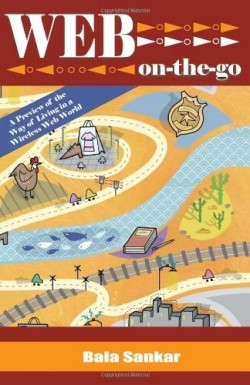Web On-The-Go
A Preview of the Way of Living in a Wireless Web World
With wireless hotspots in cafes and bookstores, cell phones that browse the Web and eBooks that download bestsellers with the touch of a button at our disposal, we may think that we are living in a wireless world already. In Web on-the-Go, though, Bala Sankar argues that we could be doing so much more with wireless technology. Extrapolating into the near future based on current inventions and infrastructure, Sankar portrays a time in which wireless is fully integrated into everyone’s lives for the good of all.
A resident of Palo Alto, California, author Sankar has a background in developing software for the major corporations of Silicon Valley, including Google. His book is the result of collaboration among industry experts and a creative team.
Sankar begins Web on-the-Go with an extensive introduction to the philosophical and historical basis of his ideas. He extols the virtue of innovation, or visionary creative thinking, blaming our current recession on a lack of innovation, rather than financial straits. While this point is highly debatable, Sankar is on firmer ground when he describes leaps forward in technology propelled by innovators such as da Vinci and Arthur Clarke, the conceptualizer of transistor radios.
The bulk of Web on-the-Go details scenarios in which a thoroughly wireless world could be useful. In one chapter, a family lost in the wilderness is found with the help of a wireless broadcast of their last known position. In another chapter, a business owner tracks containers of goods from China through embedded wireless transmitters that communicate their location. Each example stretches the possibilities of current technology to their plausible limits, arguing that improved wireless technology at all levels of society would benefit everyone.
Web on-the-Go is clearly written, and its simple style is accessible even to a non-technical audience. Some of the scenarios read like fictional scenes. The engaging presentation of the material may inspire some readers to the type of innovation that Sankar glorifies.
Unfortunately, the book tends to defeat itself. Its proposed scenarios are so similar to our current conditions that it is easy to gloss over them or to say, “So what?” The sketchy illustrations add nothing to the book, either. Finally, Web on-the-Go in its dead-tree format, as opposed to an eBook, blog posts, or a Webinar, does not take advantage of the technology praised so highly in the book, thus undermining the concept of wireless as a progressive panacea. This timely book would thrive better as a message delivered by digital or Web means.
Disclosure: This article is not an endorsement, but a review. The publisher of this book provided free copies of the book and paid a small fee to have their book reviewed by a professional reviewer. Foreword Reviews and Clarion Reviews make no guarantee that the publisher will receive a positive review. Foreword Magazine, Inc. is disclosing this in accordance with the Federal Trade Commission’s 16 CFR, Part 255.

